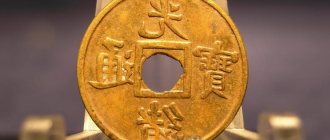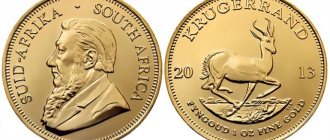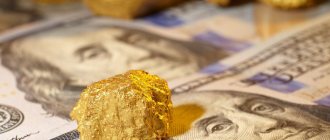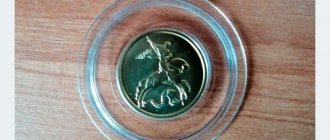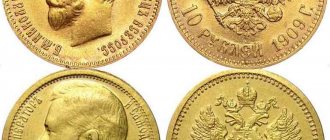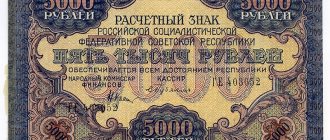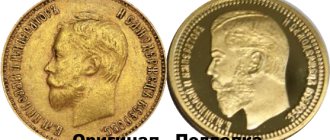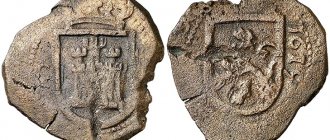Krugerrand circulation
The first mintage of Krugerrands in 1967 consisted of 40,000 coins and an additional 10,000 proof coins. In the next two years, 20,000 coins were issued, and in 1970, 211,000 coins were issued. Already since 1971, the circulation increased to 550,200 coins, and in 1972 it amounted to 543,700 coins. Examples of circulations for 2017-2018:
| Krugerrand denomination | Year of minting | Circulation (pieces) |
| 1/50 | 2018 | 50000 |
| 1/50 | 2017 | 950 |
| 1/20 | 2017 | 1900 |
| 1/10 | 2017 | 3800 |
| 1/4 | 2017 | 7900 |
| 1/2 | 2017 | 14500 |
| 1 | 2017 | 31600 |
| 2 | 2018 | 200 |
| 5 | 2017 | 195000 |
| 50 | 2017 | 1950000 |
Design development
The portrait of Paul Kruger was created by Otto Schulz , who was an engraver and coin sculptor for the Berlin Mint. It was there that the first coins for South Africa were made in 1892. Schulz's designs were also used on the obverse of all Boer coins between 1892 and 1897, and then on the obverse of the Krugerrand.
The design of the springbok antelope for the reverse of the gold Krugerrands was developed by South African sculptor Kert Steinberg. This antelope is the national animal of South Africa. Tommy Sassen is one of the first South African engravers and sculptors to undertake the task of transferring Schulz and Steinberg's designs onto the 1967 Krugerrands. The design of the Krugerrand has remained unchanged for 50 years. Only coins minted in 2021 have a small commemorative o.
Obverse
In the center of the coin is the profile of South African President Stefanus Johannes Paulus Kruger. Above it is engraved the inscription “SUID-AFRIKA*SOUTH AFRICA”, and the edge of the coin is decorated with a scalloped design.
Reverse
A running antelope is depicted in the center of the coin. Above it is the inscription “KRUGERRAND”, indicating the name of the coin. The year of minting is indicated on both sides of the antelope, and information about the composition and weight of the coin in ounces is engraved along the bottom edge. The edge of the coin is also decorated with a jagged design. On coins minted in 2021, in the upper left part of the coin relative to the antelope, the anniversary sign “50 year Anniversary 1967-2017” is engraved.
Price of Krugerrands on the market
You can buy gold Krugerrands from the first years of issue on numismatic exchanges, focusing on the following prices:
- 1/10 Krugerrand 1967 - US$2925.00 - US$3046.87;
- 1/4 Krugerrand 1980 – 386.18-402.27 US dollars;
- 1/2 Krugerrand 1980 – 682.30-710.73 US dollars;
- 1 Krugerrand 2021 – US$1274.29 - US$2350.00.
In 2021, the South African Mint released commemorative Krugerrand coins, the price of which on the market far exceeds their face value:
- 1/50 Krugerrand 2021 - $89.99 - $93.74;
- 1/50 Krugerrand 2021 – $96.08 - $129.00;
- 1/20 Krugerrand 2021 – US$144.32-229.00;
- 1/10 Krugerrand 2021 – USD 450.00 - 436.73;
- 1/4 Krugerrand 2021 - $367.29 - $719.00;
- 2021 1/2 Krugerrand - US$716.22 - US$1,145.00;
- 1 Krugerrand 2021 – USD 1274.29-2350.00;
- 1 Krugerrand 2021 – USD 2906.00-2995.00;
- 2 Krugerrand 2021 – 1224.10-1226.10 US dollars;
- 5 Krugerrands 2021 – US$13,795.00 - US$14,369.79;
- 50 Krugerrand 2021 – US$146,582.13;
- 2017 Anniversary Set of Three 1 Ounce Krugerrands - $16,295.00.
It is also worth noting that each coin has a certificate confirming its authenticity.
Investment coin cost
The popularity of the Krugerrand is evidenced by the fact that more than 50 million coins have been sold since the beginning of minting. More than 1,500 tons of gold were spent on minting coins. The Krugerrand has the status of a means of payment, but it is considered as an object for investment. The denomination is not indicated on the coin, and the value of gold coins is tied to the price of the precious metal.
As for the price, for a gold Krugerrand weighing 1 ounce, coin dealers ask 80-90 thousand rubles. New coins cost 2-3 thousand rubles more. In the case of rare gold coins, their value is several times higher than the price of the precious metal. It is determined by rarity and such specimens are not available for public sale.
Interesting Facts
- The 1/10 ounce gold Krugerrand was only introduced in 1980 to make the coin more accessible to potential investors.
- Gold Krugerrands in denominations of 1/20 and 1/50 ounce were released for the first time in 2021. All gold Krugerrands this year have a commemorative mark, but do not differ in design from coins from previous years of issue.
- When purchasing a set of several types of Krugerrands, complete with this coin you purchase a book by D. F. Malan, which tells the history of the Krugerrand. In addition, the South African Post Office issued stamp sheets and the first envelope to commemorate the fiftieth anniversary of the coin.
- In addition to gold Krugerrands, South African gold coins from the “Nature” series, which reflect the richness of South Africa’s nature, are extremely popular among numismatists around the world.
- The full name of the famous South African President, depicted on all Krugerrands, is Stefanus Johannes Paulus Kruger, better known by his rather respectful nickname “Uncle Paul”. He was President of South Africa from 1883 to 1900. In 1880, he, along with Juberomi and Pretorius, led the resistance against Great Britain, which marked the beginning of the Boer War of 1880-1881. Already in 1884, he achieved the signing of a convention, but at the same time made concessions and committed not to enter into any agreements without their approval by the British government.
- The first Krugerrands, being the legal tender of South Africa, did not have a monetary face value. At the same time, their price was fixed daily and determined by the spot gold rate. In short, Krugerrands were coins with constantly changing values.
- The first gold Krugerrands were issued annually with slight differences in diameter and thickness. Over 50 years, over 61,000,000 coins were minted, representing 58,000,000 ounces of gold. The total value of all Krugerrands issued to date is $70,000,000,000.
- The gold used to mint Krugerrands comes refined.
- During the period of instability of world currencies, investors around the world began to turn to gold assets, which significantly increased the cost of this metal. It was then, in 1967, that the Republic of South Africa introduced its Krugerrand gold coin to the world market.
Gold coins: South African Krugerrand and how to determine its authenticity
The concept of the South African Krugerrand dates back to 1964, when it was considered as a possible means of providing the general population with access to private gold ownership. The South African Mint released the first series in 1967 and this gold coin was the first of its kind in the world. The obverse of the coin depicts the profile of Paul Kruger , the fifth President of the Republic of South Africa and leader of the resistance movement against the British. The reverse side of the coin is decorated with the famous state symbol of the country, the antelope. The words "South Africa" and "pure gold" are minted in the two official South African languages - English and Afrikaans. The coin comes in four different sizes and corresponding weights. According to the country's constitution and central bank regulations, the Krugerrand is legal tender.
Until the 1980s, sales of Krugerrands around the world were so large that they accounted for 89 percent of all gold coin production. What is unique about the one ounce gold coin is that its value is based only on the current London hard gold. For this reason, Krugerrands do not have a denomination. The fantastic marketing and sales success of the Krugerrand led to other countries introducing their own gold coins by the end of the 1970s. In 1979, the Canadian Mint began producing the Gold Maple Leaf, and in 1986 the United States followed suit with the American Gold Eagle coin. However, sales of Krugerrands suffered due to European and American trade sanctions against South Africa in protest of apartheid. The production and sale of coins decreased significantly. Since the end of apartheid and the election of Nelson Mandela in 1994, the Krugerrand's market share has increased slightly, and today it accounts for about 50% of global demand for gold coins.
Standard weight of the South African Krugerrand
| Coin | Denomination | Weight | Try | Gold content | VAT |
| Gold Krugerrand | — | 1 oz | 917 | 31.10 g | 0% |
| Gold Krugerrand | — | 1/2 ounce | 917 | 15.55 g | 0% |
| Gold Krugerrand | — | 1/4 oz. | 917 | 7.775 g | 0% |
| Gold Krugerrand | — | 1/10 oz. | 917 | 3.110 g | 0% |
Gold purity in Krugerrands is 0.9170, or 91.7%. The rest of the alloy is copper, which gives the coin a reddish color. Each one ounce coin weighs 33.93 grams and contains 31.1 grams of gold and 2.83 grams of copper. Due to the success of the one ounce coin, the South African Mint began producing Krugerrands in half, quarter and tenth ounce sizes. The production of small coins was started with the intention of stimulating the gold trade, as smaller fineness makes purchasing the metal more accessible and attractive to certain target groups. Since the first series was released in 1967, more than 50 million Krugerrands have been sold, making these coins the most widely distributed in the world.
* * *
How to spot a fake Krugerrand
If you've been thinking about purchasing gold Krugerrands, the official South African gold coin, then you'll probably want to take a closer look at this coin. In particular, you may want to learn how to spot a fake. Fortunately, you will never need this skill, but it is still quite simple and almost anyone can learn it.
The best way to avoid counterfeiting is to buy coins from a professional, that is, a coin dealer who has experience dealing with Krugerrands. These sellers have been dealing with these coins for many years, so they are easily able to spot if a particular coin is the wrong shade or weight. Moreover, reliable coin sellers care about their reputation, so this will be an additional opportunity for them to confirm that they only offer genuine coins.
However, you can still easily determine the authenticity of the Krugerrand yourself. The standard specifications for these coins are published by the South African Mint and are publicly available, so you can easily check whether your coin meets these standards. In addition, you should know that gold is a special metal. In particular, it has a very high density, much higher than other commonly available metals. If you come across a counterfeit coin with less metal content, the difference in weight will be quite noticeable if you know what to look for. And metals with a density like gold are either quite difficult to get, or they are quite expensive, or they are really fragile. All of this gives you an edge when trying to determine if it's fake or not.
In terms of physical characteristics, here's what you'll need: A one-ounce Krugerrand weighs 33.930 grams, has a diameter of 32.77 mm, a thickness of 2.84 mm and 160 notches on the edge. The half-ounce coin weighs 16.965 grams, has a diameter of 27.07 mm, a thickness of 2.215 mm and 185 notches. The quarter ounce coin weighs 8.482 grams, has a diameter of 22.06 mm, a thickness of 1.888 mm and 150 notches. Finally, the one-tenth ounce coin weighs 3.393 grams, has a diameter of 16.55 mm, a thickness of 1.35 mm and 115 notches.
For the necessary measurements, you will need a ruler with millimeter divisions and accurate scales that allow you to calculate the weight in grams. If anything, there is a very smart device known as the Fisch Tester that can make all these measurements. It has a coin-shaped indentation for checking the shape, a slot for measuring thickness and diameter, and a device for measuring weight. Fisch Tester will save you a lot of time and make it easier to spot fakes. Just be careful when purchasing the tester itself on eBay, as, ironically, there have been reports of counterfeit units being sold there. If you would like to purchase a tester, consider purchasing directly from Fisch.
Armed with this new information, you can spot the fake Krugerrand yourself. Happy investing in gold!

